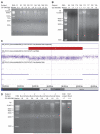Comparison of biological specimens and DNA collection methods for PCR amplification and microarray analysis
- PMID: 23241593
- PMCID: PMC3660108
- DOI: 10.1515/cclm-2012-0429
Comparison of biological specimens and DNA collection methods for PCR amplification and microarray analysis
Figures


Comment on
-
Comparison of different collection procedures and two methods for DNA isolation from saliva.Clin Chem Lab Med. 2012 Apr;50(4):643-7. doi: 10.1515/CCLM.2011.814. Clin Chem Lab Med. 2012. PMID: 22149741
References
-
- Durdiaková J, Kamodyová N, Ostatníková D, Vlková B, Celec P. Comparison of different collection procedures and two methods for DNA isolation from saliva. Clin Chem Lab Med. 2012;50:643–7. - PubMed
-
- King IB, Satia-Abouta J, Thornquist MD, Bigler J, Patterson RE, Kristal AR, et al. Buccal cell DNA yield, quality, and collection costs: comparison of methods for large-scale studies. Cancer Epidemiol Biomarkers Prev. 2002;11:1130–3. - PubMed
-
- Hansen TV, Simonsen MK, Nielsen FC, Hundrup YA. Collection of blood, saliva, and buccal cell samples in a pilot study on the Danish nurse cohort: comparison of the response rate and quality of genomic DNA. Cancer Epidemiol Biomarkers Prev. 2007;16:2072–6. - PubMed
Publication types
MeSH terms
Substances
Grants and funding
LinkOut - more resources
Full Text Sources
Other Literature Sources
Miscellaneous
